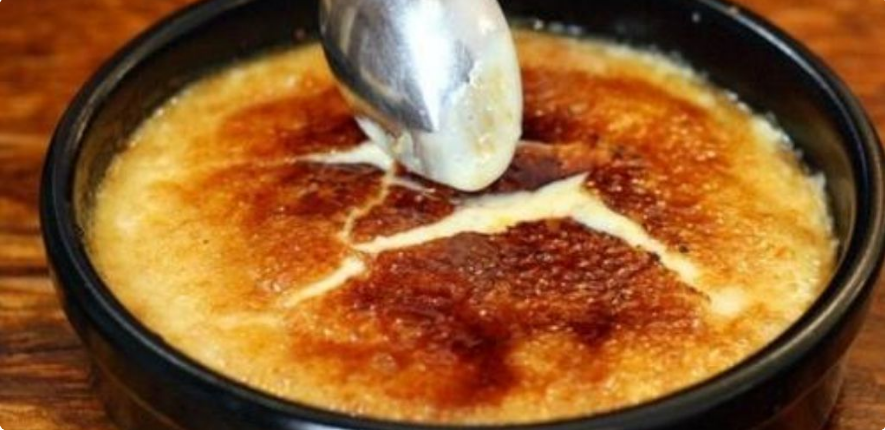Catalan cream, also known as “Crema Catalana,” is a traditional Spanish dessert similar to crème brûlée. It features a creamy custard base infused with flavors like cinnamon and lemon zest, topped with a caramelized sugar crust. Here’s a simple recipe to make Catalan cream:
Catalan cream, known as “crema catalana” in its native Catalan language, is a traditional dessert that hails from the Catalonia region of Spain. This exquisite dish is often compared to the French crème brûlée, but it boasts its own unique characteristics and flavors that set it apart. With its rich, creamy texture, delicate sweetness, and a perfectly caramelized sugar crust, Catalan cream is a beloved dessert that captures the essence of Catalan culinary traditions.
The foundation of Catalan cream is a custard made from a combination of milk, egg yolks, sugar, and cornstarch. The use of milk gives the custard a lighter texture compared to its French counterpart, which typically uses heavy cream. The egg yolks provide richness and depth of flavor, while the sugar adds sweetness. Cornstarch is often included as a thickening agent, helping to create a smooth and velvety custard that sets beautifully.
One of the defining features of Catalan cream is its aromatic flavor profile, which is enhanced by the addition of citrus zest and spices. Traditionally, the custard is infused with the zest of lemon and orange, which impart a bright and refreshing citrus note that complements the sweetness of the dish. Additionally, a cinnamon stick is often added during the cooking process, infusing the custard with warm, spicy undertones. This combination of flavors creates a delightful balance that elevates the dessert beyond a simple custard.
The preparation of Catalan cream begins by heating the milk in a saucepan along with the citrus zest and cinnamon stick. This step allows the flavors to meld together, creating a fragrant base for the custard. In a separate bowl, the egg yolks and sugar are whisked together until pale and creamy. The cornstarch is then added to the egg mixture, ensuring that it is well combined. Once the milk has reached a gentle simmer, it is gradually poured into the egg mixture while whisking continuously. This technique, known as tempering, prevents the eggs from curdling and ensures a smooth custard.
After the milk and egg mixtures are combined, the custard is returned to the saucepan and cooked over low heat, stirring constantly until it thickens. The goal is to achieve a custard that coats the back of a spoon, indicating that it is ready to be removed from the heat. Once thickened, the custard is strained to remove any lumps and then poured into individual ramekins or a large serving dish to cool. The custard is typically chilled in the refrigerator for several hours, allowing it to set completely.
The final step in preparing Catalan cream is the signature caramelized sugar crust. Just before serving, a thin layer of granulated sugar is sprinkled over the surface of the chilled custard. Using a kitchen torch, the sugar is caramelized until it forms a crisp, golden-brown crust. This process creates a delightful contrast between the creamy custard and the crunchy sugar topping. If a kitchen torch is not available, the ramekins can be placed under a broiler for a few minutes to achieve the same effect, but care must be taken to avoid burning the sugar.
When served, Catalan cream is often garnished with fresh fruit, such as berries or citrus slices, which add a pop of color and freshness to the dish. The first crack of the caramelized sugar crust reveals the smooth, creamy custard beneath, inviting diners to indulge in its rich flavors. Each spoonful offers a delightful combination of textures—the creamy custard, the crunchy sugar crust, and the aromatic notes of citrus and cinnamon.
Catalan cream is not only a delicious dessert but also a reflection of Catalonia’s rich culinary heritage. It is often enjoyed during festive occasions, family gatherings, and celebrations, making it a cherished part of Catalan culture. The dessert is typically served chilled, making it a refreshing treat, especially during warm weather
In summary, Catalan cream is a traditional dessert that showcases the rich flavors and culinary traditions of Catalonia. With its creamy custard base infused with citrus and cinnamon, topped with a perfectly caramelized sugar crust, this dessert is a delightful indulgence that is sure to impress. Whether enjoyed at a special occasion or as a sweet ending to a meal, Catalan cream is a timeless classic that captures the essence of Spanish cuisine and offers a taste of the vibrant culture of Catalonia.
Ingredients:
- – 4 cups whole milk
- – 6 large egg yolks
- – 1 cup granulated sugar
- – Zest of 1 lemon
- – Zest of 1 orange
- – 1 cinnamon stick
- – 2 tablespoons cornstarch
- – White sugar for caramelizing
Instructions:
1. In a saucepan, combine the milk, lemon zest, orange zest, and cinnamon stick. Heat over medium heat until the mixture just starts to simmer. Remove from heat and let it sit for about 15 minutes to infuse the flavors.
2. In a mixing bowl, whisk together the egg yolks and granulated sugar until well combined and slightly pale in color.
3. Remove the cinnamon stick from the milk mixture. Gradually pour the warm milk into the egg yolk mixture, whisking constantly to prevent the eggs from cooking.
4. Return the mixture to the saucepan and place it over medium-low heat. Stir continuously with a wooden spoon or silicone spatula until the mixture thickens enough to coat the back of the spoon, about 10-15 minutes.
5. In a small bowl, dissolve the cornstarch in a little bit of water to create a slurry. Stir the cornstarch slurry into the custard mixture and continue cooking for another 2-3 minutes until thickened.
6. Remove the saucepan from heat and discard the lemon zest, orange zest, and cinnamon stick. Pour the custard into individual ramekins or serving dishes. Let them cool to room temperature, then refrigerate for at least 2 hours or until fully chilled and set.
7. Just before serving, sprinkle a thin, even layer of white sugar over the top of each custard. Use a kitchen torch to caramelize the sugar until it forms a golden-brown crust. Alternatively, you can place the custards under a broiler for a few minutes to caramelize the sugar.
8. Once caramelized, let the sugar harden for a minute or two before serving to allow it to form a crunchy crust.
9. Serve the Catalan cream immediately and enjoy the creamy custard with its caramelized sugar topping.
Catalan cream is a delightful dessert that’s perfect for special occasions or anytime you crave a creamy, indulgent treat with a hint of citrus and spice. Enjoy!

